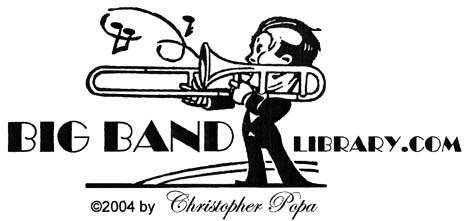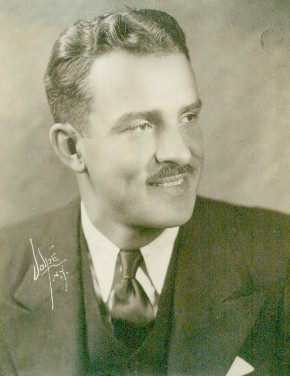
vital stats:
given name Glen Gray Knoblauch
birth June 7, 1900, Metamora, IL
death Aug. 23, 1963, Plymouth, MA, cancer
heritage German and Scottish descent
father Lurdie P.Knoblauch, a railroad worker, piano tuner, and violinist, d.1902?
mother Agnes Gray Knoblauch, remarried 1912? to George H. DeWilde
sister Mabel Knoblauch Herbst
uncle Ed B. Knoblauch
aunt Carrie Knoblauch
aunt Margaret Knoblauch
aunt Eva Knoblauch
first wife m.1925?
second wife Marion F. Douglass, b.Apr. 3, 1910, m.1932?, d.Jul. 25, 1968
son Douglass C. Gray, b.1939?
education graduate, Roanoke High School, Roanoke, IL, 1917; studied at the American
Conservatory of Music, Chicago, IL; attended one semester at Illinois Wesleyan
University, Bloomington, IL
hobbies sports (played basketball, baseball, and football at Illinois Wesleyan); golf; carpentry
[ after retirement ]
residence Plymouth, MA [ 1950- ]
physical description 6' [ or 6'4"? ] tall, slim
While a young boy, Gray had learned to play the piccolo, clarinet, flute, and, by the age of 11, the saxophone.
His father was a lifelong railroad employee, so, after Gray finished high school, he, too, worked for the railroad, first as a freight handler and then as a station manager and cashier.
But he had continued to play the sax in his spare time.
As leader of the Casa Loma band, he was a personable and stabilizing influence.
Their booking agency, Rockwell-O'Keefe, sent them on one-night stands for 101 consecutive weeks and, by mid-1931, with their precise playing and versatility, they began catching on with the public, particularly young students at college and prep-school prom dates.
The Casa Loma Orchestra did good business at venues such as the Steel Pier in Atlantic City, the Roseland Ballroom in New York City, and Glen Island Casino in New Rochelle, NY, and, beginning December 5, 1933, were selected to provide music on the "Camel Caravan" radio program.
The musicians easily shifted gears from uptempo jazz numbers (San Sue Strut, Alexander's Ragtime Band, Casa Loma Stomp, Put On Your Old Grey Bonnet, White Jazz, Black Jazz, Maniac's Ball) to smooth ballads (Smoke Rings, For You, Time On My Hands, and It's the Talk of the Town), a variety which made for good listening or dancing.
On Christmas Day 1935, when the Paramount Theatre in New York City began its new policy of having a live, famous orchestra play onstage between film showings, the Casa Loma Orchestra was their first choice. They were invited back to the Paramount each holiday season for several years in a row.
Besides Gray, members of the band included, at various times, Joe Hostetter, Sonny Dunham, and Grady Watts (trumpets), Pee Wee Hunt, Billy Rauch, and Murray McEachern (trombones), Clarence Hutchenrider (clarinet), Gene Gifford (guitar-arranger), Tony Briglia (drums), and Kenny Sargent (vocals).
It was Gifford, with his hot originals, who set much of the musical flavor of the band.
The band had first recorded for Okeh in 1929, but in 1931 switched to Brunswick and in 1934 to Decca, where they remained for 13 years and made some 275 sides (not counting transcriptions).
Several star guests recorded with the Casa Loma Orchestra during February 1939: Frankie Carle played piano on his composition Sunrise Serenade on the 17th; Louis Armstrong blew trumpet and shared the vocal with Pee Wee Hunt on both Rockin' Chair and Lazybones, made on the 20th; and Hoagy Carmichael sang Washboard Blues and Little Old Lady, cut on the 25th.
Although Gray and the Casa Loma Orchestra continued to score new hits on their own - such as Memories of You, I Cried for You, Heaven Can Wait, Under a Blanket of Blue, No Name Jive, and My Heart Tells Me - a few people expressed the opinion that, compared to newer swing bands like Benny Goodman, they no longer measured up.
With the departure of many key players, the corporation was dissolved in 1942, but Gray continued as a bandleader, retaining the Casa Loma name.
His sidemen during the 1940s included, variously, Bobby Hackett (trumpet), Bunny Bardach (alto saxophone), Herb Ellis (guitar), and Lou Fromm or Jackie Mills (drums).
What was called "road tour fatigue" and diabetes which caused circulation problems in his legs forced Gray to disband on December 19, 1947.
After a brief comeback attempt around 1949-50, he officially retired.
In June 1956, Capitol Records coaxed Gray to Los Angeles to conduct an all-star group of studio musicians in a high-fidelity recreation of the music, "Casa Loma in Hi-Fi" (Capitol W-747). He was joined by former vocalist Kenny Sargent, who sang For You and I Cried for You.
"Casa Loma Caravan" (T-856), in 1957, added more old favorites in hi-fi under Gray's direction, such as Time On My Hands, It's the Talk of the Town, and Under a Blanket of Blue.
Just in time for the wide-spread use of stereo in 1958, he was invited back for "Sounds of the Great Bands" (Capitol SW-1022), note-for-note imitations of other bands' famous hits; it took off and was quickly followed by "Sounds of the Great Bands, Vol.2" (ST-1067).
Gray returned to the Capitol studios for a number of other new albums, too: "Solo Spotlight" (ST-1147); "Swingin' Decade!: Sounds of the Great Bands [ Vol.3 ] of the 40's" (ST-1289); "Swingin' Southern Style" (ST-1400); "Please Mr. Gray (By Request) [ Sounds of the Great Bands, Vol.4 ]" (ST-1506); "Shall We Swing?" (ST-1615), which presented Billy May's adaptations of classical themes and which, though billed under Gray's name was actually led by May; "They All Swung the Blues [ Sounds of the Great Bands, Vol.5 ]" (ST-1739); and "Themes of the Great Bands [ Sounds of the Great Bands, Vol.6 ]" (ST-1812).
With the success of all of these records, Gray was encouraged to more actively return to the band business, but he refused.
Actually, his health was on the decline and his final LP, "Sounds of the Great Bands, Vol.7: Today's Best" (Capitol ST-1938), was released only two weeks before his death.
Casa Loma Orchestra Necrology - select list:
Kenny Sargent, 63, d.Dec. 20, 1969, heart attack
Gene Gifford, 53, d.Nov. 1970
Pee Wee Hunt, 72, d.June 22, 1979
Grady Watts, 77, d.Jan. 1986
Joe Hostetter, 79, d.Nov. 1986
Mel Jenssen, 82, d.Nov. 1986
Sonny Dunham, 78, d.Jul. 9, 1990, cancer
Clarence Hutchenrider, 83, d.Aug. 18, 1991
Two additional records credited to the "Glen Gray Casa Loma Orchestra," "Sounds of the Great Bands, Vol.8: More of Today's Best" (Capitol ST-2014) and "Sounds of the Great Bands [ Vol.9 ] in Latin" (ST-2131), were posthumous titles conducted by arrangers Larry Wagner and Van Alexander.
sources:
George A. Borgman, "Glen Gray and the Casa Loma Orchestra," Mississippi Rag,
Oct. 2006, p.1+.
"Deaths Elsewhere: Band Leader Glen Gray," Washington Post, Times Herald,
Aug. 25, 1963, p.B7.
Frank Driggs, "The Men Who Made the Music: Glen Gray," in The Swing Era: 1937-1938
(New York City: Time-Life Records, 1971), pp.40-47.
Charles Garrod and Bill Korst, Glen Gray And The Casa Loma Orchestra (Zephyrhills, FL:
Joyce Record Club, 1987).
"Glen Gray, Band Leader, Dies; Headed Casa Loma Orchestra," New York Times,
Aug. 25, 1963, p.83.
"Glen Gray Dies in Massachusetts," Down Beat, Sept. 26, 1963, p.13.
"Oak Grove & Vine Hills Cemetaries (Part 6 of 18 Parts)," ancestry.com.
"Singer Kenny Sargent of Glen Gray Band Dies," Los Angeles Times, Dec. 21, 1969,
p.C20.
Social Security Death Index.
Hal Smith, "Interview with Clarence Hutchenrider," Joslin's Jazz Journal, May 1987, pp.7-10.
---, "Interview with Joe Hostetter," Joslin's Jazz Journal, Feb. 1987, pp.5-8.
I would like to expand this tribute with, if possible, a new interview of someone who was important to Glen Gray's life or career. Are you an alumnus of his band, a member of his family, or a collector who is knowledgeable about his accomplishments? Please contact me via e-mail
return to "Biographical Sketches" directory
go to Big Band Library homepage
The big bands are back
in a new and exciting way!
GLEN GRAY
"CASA LOMA COOPERATIVE"
by Music Librarian CHRISTOPHER POPA
November 2008
He was playing lead alto saxophone in a 10-piece band called the Orange Blossoms, which in the fall of 1927 went to work at Casa Loma, a former castle being operated as a luxury hotel in Toronto, Ontario, Canada.
On March 10, 1930, the band incorporated, changed their name to the Casa Loma Orchestra (the hotel had closed by then) and chose Gray as their handsome, level-headed leader.
It was the first cooperative venture in the band business, with the musicians sharing in the profits, and supposedly the first white outfit to deliberately base its style on a polished, ensemble kind of jazz in which some of the players doubled on more than one instrument.
Beyond any other group, the Casa Loma Orchestra set the stage for what turned into the big band era.

Glen Gray, ca.1930s